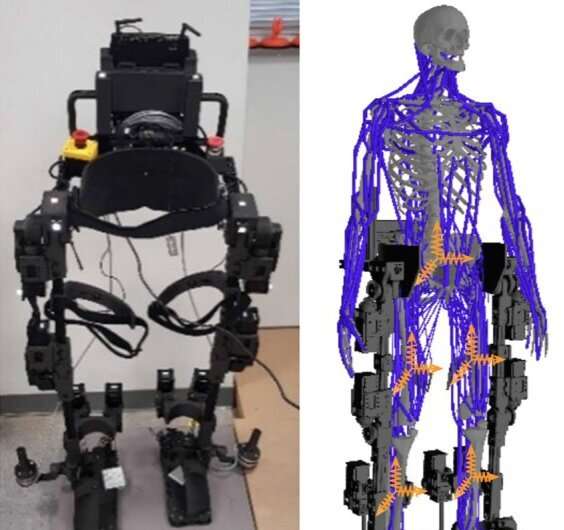This article has been reviewed according to Science X's editorial process and policies. Editors have highlighted the following attributes while ensuring the content's credibility:
fact-checked
proofread
Advanced universal control system may revolutionize lower limb exoskeleton control and optimize user experience

A team of researchers has developed a new method for controlling lower limb exoskeletons using deep reinforcement learning. The method entitled, "Robust walking control of a lower limb rehabilitation exoskeleton coupled with a musculoskeletal model via deep reinforcement learning," published in the Journal of NeuroEngineering and Rehabilitation, enables more robust and natural walking control for users of lower limb exoskeletons.
While advances in wearable robotics have helped restore mobility for people with lower limb impairments, current control methods for exoskeletons are limited in their ability to provide natural and intuitive movements for users. This can compromise balance and contribute to user fatigue and discomfort. Few studies have focused on the development of robust controllers that can optimize the user's experience in terms of safety and independence.
Existing exoskeletons for lower limb rehabilitation employ a variety of technologies to help the user maintain balance, including special crutches and sensors, according to co-author Ghaith Androwis, Ph.D., senior research scientist in the Center for Mobility and Rehabilitation Engineering Research at Kessler Foundation and director of the Center's Rehabilitation Robotics and Research Laboratory. Exoskeletons that operate without such helpers allow more independent walking, but at the cost of added weight and slow walking speed.
"Advanced control systems are essential to developing a lower limb exoskeleton that enables autonomous, independent walking under a range of conditions," said Dr. Androwis. The novel method developed by the research team uses deep reinforcement learning to improve exoskeleton control. Reinforcement learning is a type of artificial intelligence that enables machines to learn from their own experiences through trial and error.
"Using a musculoskeletal model coupled with an exoskeleton, we simulated the movements of the lower limb and trained the exoskeleton control system to achieve natural walking patterns using reinforcement learning," explained corresponding author Xianlian Zhou, Ph.D., associate professor and director of the BioDynamics Lab in the Department of Biomedical Engineering at New Jersey Institute of Technology (NJIT). "We are testing the system in real-world conditions with a lower limb exoskeleton being developed by our team and the results show the potential for improved walking stability and reduced user fatigue."
The team determined that their proposed model generated a universal robust walking controller capable of handling various levels of human-exoskeleton interactions without the need for tuning parameters. The new system has the potential to benefit a wide range of users, including those with spinal cord injuries, multiple sclerosis, stroke, and other neurological conditions. The researchers plan to continue testing the system with users and further refine the control algorithms to improve walking performance.
"We are excited about the potential of this new system to improve the quality of life for people with lower limb impairments," said Dr. Androwis. "By enabling more natural and intuitive walking patterns, we hope to help users of exoskeletons to move with greater ease and confidence."
More information: Shuzhen Luo et al, Robust walking control of a lower limb rehabilitation exoskeleton coupled with a musculoskeletal model via deep reinforcement learning, Journal of NeuroEngineering and Rehabilitation (2023). DOI: 10.1186/s12984-023-01147-2



















